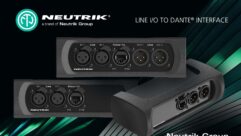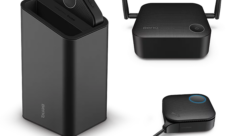SAFE AND SECURE
Jul 1, 1999 12:00 PM,
Chris M. Hoebener
The general public’s growing acceptance of new, larger and more affordableconventional video display technology creates an exciting sales opportunityfor system contractors. To keep pace with these trends, manufacturers ofvideo display mounts must provide a variety of mount design options toassist the professional system designer. As the variety of installationoptions increase, so should the emphasis on the educational needs of theprofessional installer. A comprehensive review of the safety issues uniqueto each installation proposed by the system design staff better ensuresthat the final installed system is safe for the public it serves. Thesystem designer who specifies the use of the products selected for the jobshould have a keen awareness of the public’s proximity to the video displaymount location and select the best support system for each application. Itis the intent of this article to discuss general wall and ceiling mountsafety issues and design standards currently available for largerconventional video displays. A-V system designers and support productmanufacturers have the responsibility to provide professional installersthe instructions and product information required for safe systeminstallation.
Industry design standardsThe wall mount shelf design creates a cost-effective support platform forthe video display cabinet footprint. Typically, the video display cabinetshould be secured by a flexible nylon strap that is secured to the baseplatform structure to create mechanical contact to the top of the videodisplay cabinet. Generally, the designer should pay particular attention tothe use of this design in commercial applications because of the limitedrigid mechanical attachment to the video display cabinet. Selecting wallmount locations that minimize the opportunity for side impact to the mountarmature or video display cabinet should be considered when selecting awall mount shelf design. The nylon safety belt should include an adhesivesecuring attachment that bonds to the video display cabinet to prevent itfrom slipping through the belt that secures it to the platform. Inaddition, the designer should realize that the flexible nylon belt can beremoved without the use of tools and may not be replaced when monitors areremoved and reinstalled by facility maintenance personnel. By adding studspanning support accessories, the system designer can increase the wallattachment safety by spreading the side and top shear force over a greaterwall surface area and multiple wall fastener heads. Keep these two tips inmind when selecting a wall mount shelf design-install the mount to morethan one wall stud for steel and wood stud installations, and be sure thatthe mount’s wall support hardware hole pattern is spread widely enough tohit multiple blocks when using expansion fasteners for attachment toconcrete block and masonry walls.
The wall mount yoke design creates a firm mechanical hold on all four sidesof the video display cabinet. With the mount maintaining positivemechanical contact to the video display cabinet perimeter, a safermechanical ability to tilt and hold the video display cabinet downward forviewing presentation is achieved. Installations of video displays to wallmount locations in close proximity to the ceiling line or to walls higherthan 8 feet (2.4 m) can be achieved more safely by selecting a wall mountyoke design. When the wall mount yoke design is installed, the steelperimeter of the mount can assist the conventional plastic video displaycabinet in surviving side contact abuse. The amount of hardware connectionpoints to the supporting wall and the addition of support spans that allowattachment to multiple support studs helps ensure that the weight load canbe supported over the life of the installation. Attachment to more than onesupport stud also ensures that commercial grade steel studs can support theload requirements. In addition, the increased wall surface contact andadditional wall fastener points help reduce side-to-side play on theprotruding support armature. Keep these two tips in mind when selecting awall mount yoke design-the mount should have a load support span attachmentto allow connection to at least three support studs, and the mount shoesshould connect mechanically to each other by a connecting support plateaccessory. Connecting the support shoes across the mount base prevents theshoes from spreading or flexing under weight loads created by heavier videodisplay cabinets.
The ceiling mount yoke design maintains the same mechanical hold to theperimeter of the video display cabinet as the wall mount yoke design. Thereis a load-bearing mechanical advantage to a ceiling mount yoke designcreated by the ability of the installer to locate the ceiling mount supporttube connection directly over the video display cabinet’s center ofgravity. Hardware connection points for ceiling mounts can be verified bythe installer by access through suspended ceiling tiles. The professionalinstaller should verify the connection of the 1.5 inch (38 mm) steelsupport pipe to a legitimate load-bearing steel beam or truss wheninstalling mounts to existing ceiling construction. In addition, theinstaller should verify that the truss attachment location and connectinghardware selected can support loads equivalent to four times the mountmanu-facturer’s specified load support rating. By knowing the beam andtruss construction standards to look for, the installer can be assured thatthe properly installed ceiling mount provides the safest design availableto public access areas. Keep these two tips in mind when selecting aceiling mount yoke design-the mount shoes should connect to each othermechanically by a custom plate to prevent the shoes from spreading orflexing under weight loads created by heavier video display cabinets, andif you choose to use a custom ceiling plate attachment accessory tocomplete your installation, check the distance between the fastenerlocations that are pre-drilled on the plate to ensure compliance with anyhardware specification you source to attach the plate to the ceiling. Also,check the load specification and UL listing for the attachment hardwareselected.
Comparing mountsThe Underwriters’ Laboratory test standard UL 1678 for household,commercial and professional use of carts and stands would be the primaryindependent industry benchmark for checking a manufacturer’s loadperformance claim. To compare available mount designs and ensure he hasselected the proper mount for the application, a designer should look for aUL symbol on the manufacturer’s load specification for each mount produced.To summarize, UL 1678 test standards relating to mount certificationrequire each mount design to be tested to support four times the loadweight that the manufacturer specifies. The UL test standards providedesigners an objective professional engineering review of load supportperformance claims made by manufacturers of mount systems. It is wise toinquire from the manufacturer what the UL standard criteria covers when aUL certification is referenced for support systems and hardware. Doing soallows the designer and installer to be better informed when selecting themounts and hardware and not to assume that if UL certification is claimedthat certain support system application safety concerns are addressed.Without objective UL tests on mount load specification adherence bymanufacturers, designers would have to trust that manufacturers haveperformed objective product tests to assess the strength of each mountdesign produced. The manufacturer pays a fee to the UL for tests conductedon each mount design for a certification relating only to the criteria thatthe UL 1678 standard requires. Adjustable mount designs must also be testedin the position least favorable to support the manufacturers specifiedload. To determine the load rating needs for each mount application, addthe weight of the mount plus the video display weight and times that amountby four to determine the mount’s application maximum load contingencyrating needs. Once manufacturer’s load ratings are compared, the designerwill find some mounts manufactured and advertised to support comparableconventional video display cabinet sizes that do not have UL 1678certification and that were designed with a smaller contingency loadsupport capability. Designers need to remember to look for themanufacturer’s specified load rating when selecting a mount first and thencheck for the UL 1678 certification of the mount.
Final thoughtsSafe, professional installation of video display systems should be thenumber one objective for designers, installers and manufacturers as theindustry continues to grow. New video display technology and new public andprivate investment into the use of these visual display technologiesprovide the real growth opportunity for system design companies and supportproduct manufacturers. Professional system designers must demand thatsupport manufacturers design mounts that address the UL 1678 concerns foradditional contingency load-bearing capability for unforeseen hazards.Designers must ensure that the mount contingency load rating they selectfits the installation environment and must not use a non-compliant or lightload contingency rated design for short-term cost savings. As withinstallation of support devices of any nature, do not underestimate theneed for a post installation review to allow the installer and designer achance to discuss the installation experience in general and make sure anyissues concerning safety are addressed to prevent unsafe productapplications in the field. The review will also allow the designer andinstaller to develop a product performance information base to assist infuture system product selections andprovide customers with the best systeminstallation available.










